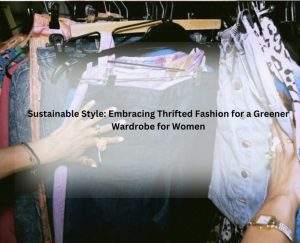Sustainable Style: Embracing Thrifted Fashion for a Greener Wardrobe for Women

Author: Amelia Lopez
Introduction
In a world that is increasingly perceiving the importance of sustainability, the fashion business is no particular case. As women become more aware of purchasers, embracing thrift fashion has gained force. Thrifted clothing not only offers an affordable and one-of-a-kind way to communicate personal style but also adds to a greener planet. In this era of fast fashion, women are going to thrift finds, reclassifying the idea of a trendy wardrobe while limiting environmental impact.
The Environmental Impact of Fast Fashion: A Wake-Up Call
Fast fashion, characterized by rapid creation cycles and rapidly changing patterns, has detrimentally impacted the climate. From unreasonable water usage to the generation of material waste, the conventional fashion industry has been a significant supporter of environmental degradation. Women’s fashion outfits, frequently attached to seasonal patterns and short item lifecycles, bring about a constant practice of utilization and disposal.
The term sustainable style is gaining undoubted popularity as individuals look for alternatives to the environmental cost of fast fashion. Thrifted fashion arises as a vital participant in this development, offering an answer that aligns with style and sustainability.
Thrifting: A Treasure Chase after Women’s Fashion Outfits
Thrifting is beyond a practical way to shop; it’s an adventure. Scouring secondhand shops, vintage shops, or even internet-based platforms for pre-cherished pieces can unearth unexpected yet invaluable treasures that recount a story. From classic denim jackets to retro dresses, thrifted fashion allows women to curate a wardrobe as attractive as they are.
Key Advantages of Embracing Thrifted Fashion
1. Reducing Fashion Footprint
Choosing recycled clothing decreases the demand for new creations, limiting the environmental impression associated with manufacturing, transportation, and packaging.
2. Promoting Circular Fashion
Thrifting encourages a circular fashion economy by expanding the existing pattern of dress things. At the point when women trade used pieces, they actively participate in diminishing material waste.
3. Affordable and Accessible Style
Thrifted fashion is often more financially planned and well disposed of than purchasing new attire. It allows women to explore different avenues regarding assorted styles without breaking the bank.
4. Quality Finds with Character
Vintage pieces or all-around maintained recycled things frequently boast prevalent craftsmanship and unique details, adding character to one’s wardrobe.
5. Expressing Personal Style
Thrifted fashion offers a diverse blend of styles from various eras, enabling women to communicate their individuality in a way that may not be achievable with mass-created, cutout fashion.
Sustainable Lounge Wear: Comfort with a Conscience
The ascent of sustainable style stretches out past everyday wear to women’s lounge wear, a category that has gained particular attention lately. Comfortable and versatile, loungewear has turned into a staple in many wardrobes. Embracing sustainable practices in loungewear aligns with the broader development of eco-accommodating fashion.
The most effective method to Incorporate Sustainability into Women’s Lounge Wear
1. Choose Quality Fabrics
Choose loungewear from sustainable and organic fabrics like bamboo, Tencel, or organic cotton. These materials are comfortable as well as eco-accommodating.
2. Support Ethical Brands
Investigate loungewear brands that focus on ethical and sustainable practices in their creation processes. Brands with transparent inventory chains and eco-accommodating certifications add to a greener fashion industry.
3. Extend the Existence of Lounge Wear
Instead of discarding broken-down loungewear, consider upcycling or reusing. Transform an old shirt into comfortable shorts or use fabric scraps for Do-It-Yourself projects. This lessens waste and adds a personalized touch to your loungewear assortment.
4. Mindful Consumption
Focus on need overabundance with regards to loungewear. Putting resources into some quality pieces that align with your style and comfort inclinations guarantees a more sustainable and intentional approach to your wardrobe.
Enabling Change: Making Sustainable Style Mainstream
As women increasingly advocate for sustainable style, the fashion business is shifting towards more eco-cognizant practices. Thrifted fashion and sustainable loungewear are not simply drifted; they address a cultural shift towards careful utilization and a promise to environmental obligation.
How Women Can Drive Sustainable Style
1. Educate and Share
Share information about the environmental impact of fast fashion and the advantages of thrifting with companions and social circles. Education is an integral asset for driving aggregate change.
2. Support Sustainable Initiatives
Decide to help brands and initiatives that focus on sustainability. By underwriting eco-accommodating choices, women add to the demand for mindful and ethical fashion.
3. Organize Dress Swaps
Have clothing swap occasions inside your local area or social circles. Swapping pre-cherished things allows for a reviving wardrobe update without adding to additional creation.
4. Advocate for Transparency
Demand transparency from fashion brands regarding their creation processes, obtaining of materials, and labor practices. This push for accountability encourages the business to adopt more sustainable practices.
Conclusion
In conclusion, sustainable style isn’t simply a passing pattern; a development engages women to make environmentally conscious decisions without settling on style and comfort. Thrifted fashion and sustainable loungewear allow self-articulation while adding to a greener and more ethical fashion landscape. By embracing thrift treasures and picking eco-accommodating loungewear, women play a crucial job in shaping a fashion industry that isn’t just stylish but also mindful.
Author: Amelia Lopez
For more great blogs on fashion go to Modaville blog.
